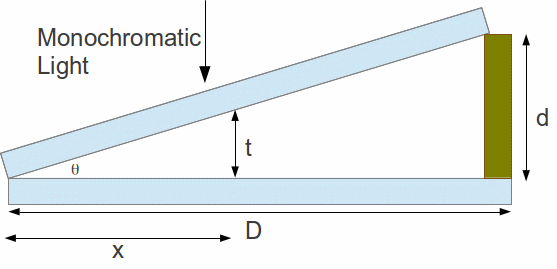Wedge Fringes
When two glass slides are place together at one end with an angle between them as below, and illuminated by monochromatic light, bright fringes will be seen whenever the path difference of light reflected from the top and bottom edges of the gap is a whole number of wavelengths.

Light undergoes a phase change of %pi on reflection from a denser medium. This will happen on reflection from the upper face of the bottom slide.
The path difference is 2t between light reflected from the bottom suface of the upper slide and the top suface of the lower slide. Since there is a phase change of %pi for light reflected from the upper surface of the lower slide, the condition for constructive interference, so that bright fringes are produced, is![]() and the condition for destructive interference, so that dark fringes are produced, is that
and the condition for destructive interference, so that dark fringes are produced, is that![]()
From the diagram above![]() so we can write the condition for bright fringes as
so we can write the condition for bright fringes as![]() and the condition for dark fringes as
and the condition for dark fringes as![]()
To see the fringes clearly the angle![]() must be very small – only a few minutes of arc. They may then be seen with a travelling microscope positioned above the slides. The same phenomena is displayed by a vertical soap film. The film drain towards the bottom, forming a wedge of small angle. When the top goes black the thickness of the top of the film is virtually zero and it is about to break.
must be very small – only a few minutes of arc. They may then be seen with a travelling microscope positioned above the slides. The same phenomena is displayed by a vertical soap film. The film drain towards the bottom, forming a wedge of small angle. When the top goes black the thickness of the top of the film is virtually zero and it is about to break.